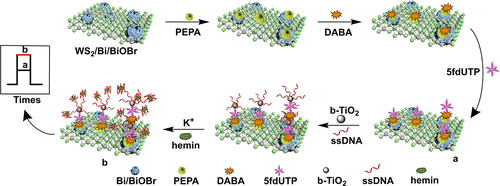当前位置:
X-MOL 学术
›
ACS Appl. Nano Mater.
›
论文详情
Our official English website, www.x-mol.net, welcomes your feedback! (Note: you will need to create a separate account there.)
WS2/Bi/BiOBr Nanostructures for Photoelectrochemical Sensing of 5-Formyluracil-2′-deoxyuridine-5′-triphosphate through Hemin/G-Quadruplex Double Signal Amplification
ACS Applied Nano Materials ( IF 5.9 ) Pub Date : 2021-08-30 , DOI: 10.1021/acsanm.1c01585 Qian Wang 1 , Huanshun Yin 1 , Jia Ding 1 , Yunlei Zhou 1 , Shiyun Ai 1
ACS Applied Nano Materials ( IF 5.9 ) Pub Date : 2021-08-30 , DOI: 10.1021/acsanm.1c01585 Qian Wang 1 , Huanshun Yin 1 , Jia Ding 1 , Yunlei Zhou 1 , Shiyun Ai 1
Affiliation

|
5-Formyluracil (5fU) is considered an important epigenetic modification agent involved in gene regulation, cell differentiation, and development. 5fU exists in many cells and tissues but is highly similar to the structure of 5-formylcytosine (5fC) and is less abundant in genome. Therefore, the development of a rapid, sensitive, and highly selective method to detect 5fU is desired. In this study, a photoelectrochemical biosensor based on WS2/Bi/BiOBr nanocomposites, black TiO2 (b-TiO2), and hemin/G-quadruplex was described, which was found to be highly sensitive and selective for 5-formyluracil-2′-deoxyuridine-5′-triphosphate (5fdUTP) detection. WS2/Bi/BiOBr was first employed as a photosensitive material, and 3,4-diaminobenzoic acid (DABA) was adopted as a 5fdUTP recognition and capture reagent, where DABA was captured by polyethylene polyamine through covalent reaction to form a stable amid bond. Then, a benzimidazole bond was formed between DABA and −CHO of 5fdUTP, and 5fdUTP was selectively captured on the electrode. Using b-TiO2 as a cross-linker, a guanine-rich ssDNA sequence was further immobilized on the electrode surface by covalent reaction with the 5fdUTP phosphate group. With the assistance of K+ and hemin, the hemin/G-quadruplex structure was formed on the electrode. The hemin molecules in the structure of hemin/G-quadruplex obviously enhanced the PEC response of the biosensor for detecting 5fdUTP, with a linear range of 0.005–500 nM and a detection limit of 1.53 pM (S/N = 3). In addition, this method exhibits optimistic selectivity. The precision and accuracy of this method were evaluated by studying the content of 5fdUTP in genome DNA of crop tissues with standard addition recovery experiments.
中文翻译:

WS2/Bi/BiOBr 纳米结构用于 5-Formyluracil-2'-deoxyuridine-5'-triphosphate 通过 Hemin/G-Quadruplex 双信号放大的光电化学传感
5-甲酰尿嘧啶 (5fU) 被认为是参与基因调控、细胞分化和发育的重要表观遗传修饰剂。5fU 存在于许多细胞和组织中,但与 5-甲酰胞嘧啶 (5fC) 的结构高度相似,在基因组中含量较少。因此,需要开发一种快速、灵敏、高选择性的 5fU 检测方法。在本研究中,描述了一种基于 WS 2 /Bi/BiOBr 纳米复合材料、黑色 TiO 2 (b-TiO 2 ) 和氯化血红素/G-四联体的光电化学生物传感器,发现其对 5-甲酰尿嘧啶具有高度敏感性和选择性。 2'-脱氧尿苷-5'-三磷酸(5fdUTP)检测。WS 2/Bi/BiOBr首先被用作光敏材料,3,4-二氨基苯甲酸(DABA)被用作5fdUTP识别和捕获试剂,其中DABA被聚乙烯多胺通过共价反应捕获形成稳定的酰胺键。然后,DABA与5fdUTP的-CHO之间形成苯并咪唑键,5fdUTP被选择性地捕获在电极上。使用 b-TiO 2作为交联剂,通过与 5fdUTP 磷酸基团的共价反应,将富含鸟嘌呤的 ssDNA 序列进一步固定在电极表面。在 K +的帮助下和氯化血红素,电极上形成氯化血红素/G-四链体结构。hemin/G-quadruplex结构中的hemin分子明显增强了生物传感器检测5fdUTP的PEC响应,线性范围为0.005-500 nM,检测限为1.53 pM(S / N =3)。此外,该方法表现出乐观的选择性。通过标准添加回收实验研究作物组织基因组DNA中5fdUTP的含量来评估该方法的精密度和准确度。
更新日期:2021-09-24
中文翻译:

WS2/Bi/BiOBr 纳米结构用于 5-Formyluracil-2'-deoxyuridine-5'-triphosphate 通过 Hemin/G-Quadruplex 双信号放大的光电化学传感
5-甲酰尿嘧啶 (5fU) 被认为是参与基因调控、细胞分化和发育的重要表观遗传修饰剂。5fU 存在于许多细胞和组织中,但与 5-甲酰胞嘧啶 (5fC) 的结构高度相似,在基因组中含量较少。因此,需要开发一种快速、灵敏、高选择性的 5fU 检测方法。在本研究中,描述了一种基于 WS 2 /Bi/BiOBr 纳米复合材料、黑色 TiO 2 (b-TiO 2 ) 和氯化血红素/G-四联体的光电化学生物传感器,发现其对 5-甲酰尿嘧啶具有高度敏感性和选择性。 2'-脱氧尿苷-5'-三磷酸(5fdUTP)检测。WS 2/Bi/BiOBr首先被用作光敏材料,3,4-二氨基苯甲酸(DABA)被用作5fdUTP识别和捕获试剂,其中DABA被聚乙烯多胺通过共价反应捕获形成稳定的酰胺键。然后,DABA与5fdUTP的-CHO之间形成苯并咪唑键,5fdUTP被选择性地捕获在电极上。使用 b-TiO 2作为交联剂,通过与 5fdUTP 磷酸基团的共价反应,将富含鸟嘌呤的 ssDNA 序列进一步固定在电极表面。在 K +的帮助下和氯化血红素,电极上形成氯化血红素/G-四链体结构。hemin/G-quadruplex结构中的hemin分子明显增强了生物传感器检测5fdUTP的PEC响应,线性范围为0.005-500 nM,检测限为1.53 pM(S / N =3)。此外,该方法表现出乐观的选择性。通过标准添加回收实验研究作物组织基因组DNA中5fdUTP的含量来评估该方法的精密度和准确度。



























 京公网安备 11010802027423号
京公网安备 11010802027423号